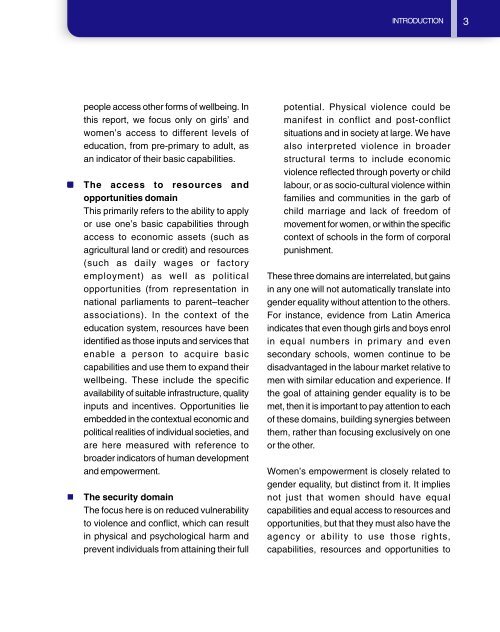Cover(final) - United Nations Girls' Education Initiative
Cover(final) - United Nations Girls' Education Initiative
Cover(final) - United Nations Girls' Education Initiative
Create successful ePaper yourself
Turn your PDF publications into a flip-book with our unique Google optimized e-Paper software.
INTRODUCTION 3<br />
people access other forms of wellbeing. In<br />
this report, we focus only on girls’ and<br />
women’s access to different levels of<br />
education, from pre-primary to adult, as<br />
an indicator of their basic capabilities.<br />
• The access to resources and<br />
opportunities domain<br />
This primarily refers to the ability to apply<br />
or use one’s basic capabilities through<br />
access to economic assets (such as<br />
agricultural land or credit) and resources<br />
(such as daily wages or factory<br />
employment) as well as political<br />
opportunities (from representation in<br />
national parliaments to parent–teacher<br />
associations). In the context of the<br />
education system, resources have been<br />
identified as those inputs and services that<br />
enable a person to acquire basic<br />
capabilities and use them to expand their<br />
wellbeing. These include the specific<br />
availability of suitable infrastructure, quality<br />
inputs and incentives. Opportunities lie<br />
embedded in the contextual economic and<br />
political realities of individual societies, and<br />
are here measured with reference to<br />
broader indicators of human development<br />
and empowerment.<br />
• The security domain<br />
The focus here is on reduced vulnerability<br />
to violence and conflict, which can result<br />
in physical and psychological harm and<br />
prevent individuals from attaining their full<br />
potential. Physical violence could be<br />
manifest in conflict and post-conflict<br />
situations and in society at large. We have<br />
also interpreted violence in broader<br />
structural terms to include economic<br />
violence reflected through poverty or child<br />
labour, or as socio-cultural violence within<br />
families and communities in the garb of<br />
child marriage and lack of freedom of<br />
movement for women, or within the specific<br />
context of schools in the form of corporal<br />
punishment.<br />
These three domains are interrelated, but gains<br />
in any one will not automatically translate into<br />
gender equality without attention to the others.<br />
For instance, evidence from Latin America<br />
indicates that even though girls and boys enrol<br />
in equal numbers in primary and even<br />
secondary schools, women continue to be<br />
disadvantaged in the labour market relative to<br />
men with similar education and experience. If<br />
the goal of attaining gender equality is to be<br />
met, then it is important to pay attention to each<br />
of these domains, building synergies between<br />
them, rather than focusing exclusively on one<br />
or the other.<br />
Women’s empowerment is closely related to<br />
gender equality, but distinct from it. It implies<br />
not just that women should have equal<br />
capabilities and equal access to resources and<br />
opportunities, but that they must also have the<br />
agency or ability to use those rights,<br />
capabilities, resources and opportunities to

















